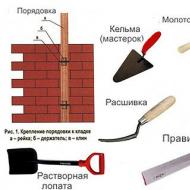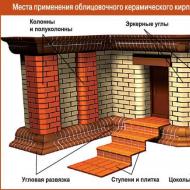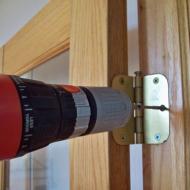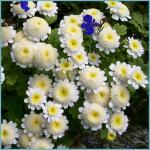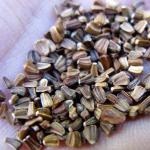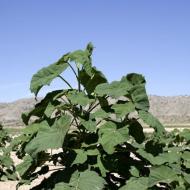
Ash soap with their own hands. DIY ash soap
Ash soap based on lye is the safest and most famous detergent from ancient times. Natural ingredients added to this soap soften its properties and make it suitable for both household use and personal hygiene. Let's find out how to make ash soap at home.
The basis of ash soap is an aqueous infusion of ash, called lye. This infusion is strongly alkaline and contains sodium and potassium carbonates. In ancient times, this infusion was used instead of the usual soap for washing and washing.
How to make lye
There are 2 ways: hot and cold.
hot way: put 12 tablespoons in a 5 liter container. (about 4 handfuls) of ash and pour 2.5 liters of water. Boil over low heat, stirring. The water will gradually evaporate. Let it brew for 8-10 hours. The ashes will settle to the bottom, and the fat-free liquid lye will remain at the top. Drain it carefully. The result should be about 1.5 liters of lye.
cold way: in a glass jar for 3/4 of the volume, put the ashes and add 1/4 of the water. Stir regularly during the first day. On the second and third days, do not touch. After that, carefully pour into a clean jar through a filter.

How to use lye
- for washing hair and personal hygiene you can use lye prepared in a simpler way. To do this, skip the water through one portion of the ash. This lye has a slight concentration and does not dry the skin.
- for dish washing you can use the recipe above, but with increased concentration. To do this, skip one part of the water through several new portions of ash. Get a strong and thick lye.
- for washing and cleaning lye prepared according to the cold method is suitable.
When washing and cleaning, concentrated lye is used, so it can dry out the skin. If desired, you can use gloves or other means to protect the skin.

Interesting: the concentration of lye also depends on the ash of which plant it was prepared from. For example, sunflower ash contains the most potassium carbonates - 30-35%, birch ash - 12%, buckwheat straw - 35%.

How to store prepared lye?
It is best to store lye in a glass container. It corrodes plastic cans, which will begin to leak over time.
Ash soap - natural detergent
A more convenient way to use lye is soap based on it. The technology of making ash soap has survived to this day. To make soap from ash, you will need a pot-type container. An important condition: it should not be aluminum!

Ash Soap Ingredients:
- 2 parts concentrated lye (prepared using the hot method, see above);
- 1 part melted pork fat;
- table salt (the exact amount depends on many factors, including the concentration of lye).
Ash soap preparation
1. Add pork fat to the lye and slowly heat over a fire. When the saponification process begins, the liquid will first acquire a milky color, then the solution will brighten. Gradually, the fat from the surface will turn into an emulsion, and the mass will thicken.
2. To continue the saponification process, add lye in parts of 100 g. Gradually, the mass will become transparent. The mass must be stirred regularly. The foam that forms is best removed.
3. When the mass begins to thicken, the so-called. soapy glue, similar in consistency to thick jelly. Such a mass will flow from the spatula not in drops, like an emulsion, but in a trickle.
4. When the soap glue is ready, you need to make a peeling. Slightly reduce the heat and scatter the first portion of salt over the surface and mix without touching the bottom. Gradually continue to add salt until the mass becomes like cottage cheese and floats.
5. Remove from heat, leave the container overnight to exfoliate the brine.
6. Carefully separate the soap and brine, then add a new portion of lye from a 1: 1 ratio. And repeat the process. The second brew will be faster.
7. This time continue to salt until the soap floats. In this case, there will be no curdled mass, instead it will turn out just a thick mass. For its upholding, 1.5-2 hours are enough. Using a colander covered with a cloth, filter the mass. Soap and brine will separate.
8. Leave the mass for 1.5-2 hours, and then decompose into molds for a day, then remove and dry.
 The more boiling-salting processes the soap has passed, the better it is. To improve the properties of soap, you can melt it and add your favorite base or essential oils: for example, olive and lavender.
The more boiling-salting processes the soap has passed, the better it is. To improve the properties of soap, you can melt it and add your favorite base or essential oils: for example, olive and lavender.
See for laundry, cleaning and hygiene
Ash soap perfectly and instantly washes the skin and head, it is a pleasure to wash it - a feeling of extraordinary cleanliness and freshness.
Ash soap
Ash soap perfectly and instantly washes the skin and head. It is a pleasure to wash them - a feeling of extraordinary cleanliness and freshness. sti.
Ash soap is made like this: typed from the stove ash floor pans. Top up with water almost to the top and boil for 30 minutes. The broth is filtered, the remains of the ash are put into the garden.
The resulting almost transparent gel is the ash soap - it has cooled down and is ready for use.
To make the soap completely natural, the lye obtained industrially and bought in the store can be replaced with lye made by oneself.
Lye is a solution of ash in water. To make everything right, it is recommended to use wood ash. And only deciduous trees. Conifers contain resins in their composition and are not suitable for making soap.
Lye is washed and washed. It would be more accurate to say that our great-great-grandmothers and great-great-grandfathers did all this. Now only people who run away from civilization and organize ecovillages are engaged in such miracles.
In principle, it is not so difficult to prepare lye, or rather, it is not at all difficult to say.
There are two ways to obtain this substance: cold and hot. The most hassle-free, of course, the cold way. But lye is obtained faster if it is mined in a hot way.
How to make lye from ashes?
To do this, the ashes should be sieved to rid it of dirt, large pieces of debris and excess impurities. The proportion will be 2/3 of ash + 1/3 of water.
Pour the ashes into a bucket and fill with water. This mixture should not be touched (interfered) for 3 days. During this time, the mixture will delaminate and lye will appear on top, and the ash will settle to the bottom.
With the hot method, a mixture of water and ash is boiled for 2-3 hours, and then defended and also filtered. But safer!!! still cold way
Lye is poured into another container, while simultaneously filtering if necessary. To the touch, this liquid will be soapy and very concentrated. It is recommended to dilute lye 1/10 if you plan to wash it.
Lye soap recipe.
Often many people ask the question: can you make soap without using lye? You can if you use lye.
This will require 2 liters of lye per 1 kg of pork fat (other fat can be used). All this is mixed and boiled for at least 8 hours, stirring constantly. First, liquid soap will appear - "potash". And to get our usual solid soap, you should add salt, a good handful. All the dirt will float to the surface, and the soap will separate. Get the so-called sound soap. It must be caught and put into shape. After hardening - cut into pieces - and laundry soap is ready.
If you add useful ingredients: caring oils, glycerin, esters, etc. Toilet soap is also available.
It is clear why our ancestors did not have problems with hair until old age, and there is not a single mention of dandruff in the annals.
It is necessary to break out of the ambush of scientific absurdity forward into the will of an almost forgotten natural clean and healthy life, created so wisely that it can only be improved to spoil.
Step by step, breakthrough by breakthrough, correction by correction.published
Lye is a wonderful natural remedy used by our ancestors.
It can be used for washing, washing hair, body and dishes.
This is an environmentally friendly product - it does not contain any preservatives, or chemistry, or all those harmful substances that are found in large quantities in modern products - it not only does not pollute nature, but is also very useful - for example, used lye is good for watering a garden.
Lye is prepared from the ashes. Of course, it is more convenient to do this in your own home, but you can also take it in an apartment - take it from friends or in the country.
Cooking:
Pour a third of an enameled bucket of wood ash (namely, wood ash, not products of combustion of household waste. They say that the ash of deciduous trees “works” better than coniferous trees. Especially birch and alder ash).
Fill the ash with water to the top of the bucket, remove large particles that have surfaced. Then there are options.
- Let the ashes brew in water for 3 days (preparation of lye in a cold way).
- Boil the resulting mixture until it becomes soapy to the touch and almost transparent (to check readiness, you can pour some water from a bucket and evaluate its properties). The lye boiling time can be about an hour, maybe more.
Let the resulting mixture settle, and then carefully drain the “water” so that ash does not get in - this is lye!
Lye must be diluted with water 1 to 10 or even more! Otherwise, you can ruin both the skin and clothes!
Also, lye is useful for oral administration in various diseases, such as flatulence, colic in the stomach, increased acidity of gastric juice, and especially in case of poisoning with berries and bacterial toxins, and also contributes to the accelerated removal of radioactive isotopes from the body.
Ash can also be used to bleach laundry: boil it by adding a bag of wood ash. At the same time, the lye will be prepared. There is an opinion that with this method of bleaching, the linen not only does not deteriorate (as far as it is possible in principle when boiling), but even becomes even stronger! (from the book of G. Ya. Fedotov "Russian stove").
This is such a miracle cure!
How we were all fooled by slipping chemistry 50 years ago instead of real soap, which has been used for centuries. Ash soap perfectly and instantly washes the skin and head. It is a pleasure to wash them - a feeling of extraordinary cleanliness and freshness.
Ash soap is made like this: the ashes of half a pan are collected from the stove. Top up with water almost to the top and boil for 30 minutes. The fat is filtered, the remains of the ash are thrown into the garden. The resulting almost transparent gel is the ash soap - it has cooled down and is ready for use.
It is clear why our ancestors did not have problems with hair until old age, and there is not a single mention of dandruff in the annals.
Personal hygiene is an important part of daily life. Soap is most often used for bathing. Its wide variety allows you to choose the most suitable. Ash soap is an equally effective personal hygiene product. You can cook it yourself. How to make soap from ashes is described in the article.
What will be required?
Do-it-yourself ash soap is easy to prepare. You just need to prepare everything you need for this:
- Ash. It is obtained after burning wood. If it is resinous, for example, from spruce or pine, then ash is required, previously mixed with fat, to neutralize the resin. To replace this component will allow caustic soda, which is called soapstone.
- Water. It can be ordinary, but it is better to choose soft. Rigid enters into chemical reactions with alkali and partially neutralizes it.
- Fat. It can be fatty waste, lard, subcutaneous fat and various animal waste.
- Salt. You should choose a cookery.

Based on these components, soap is made from ash. It is used for daily bathing and washing. It perfectly fulfills its hygienic functions.
Cooking rules
Ash soap recipe is very simple. To do this, pour a little water into two containers: a large one and a slightly smaller one. Do not use aluminum cookware. Add ash to the water and boil for 30 minutes. During this period, a precipitate will appear - it is not applied. And the resulting liquid will be a light lye.

The same amount of fat is added to the lye, after which the mixture should be boiled. Gradually add more lye. You should get a substance that can solidify during the test - liquid sweat soap or soap glue.
Further actions
You should take this soap glue, freed from greasy residues and sediment, and add table salt to it. As a result of the reaction, a dense soap core appears - soda soap. The solution must be stirred by adding salt. The core will expand until all the soap glue has been converted into it.
Then the finished soap from the ashes must be removed from the container and transferred to another boiler. The most concentrated lye, pre-boiled, and table salt are added here. Ash soap becomes thicker - now it can be used for hygiene. But you can do this after removing excess lye, which is harmful to the skin. This technology is used to prepare, for example, soap from birch ash.
Final stage
At the end, the resulting shaping substance is placed in a wooden box on linen or other linen. Soap from the ashes should harden, lye should flow down. The product is cut into pieces and used at your discretion. Soap should be stored with grease.

It is advisable to carry out all stages of the procedure, except for the first one, on the street, otherwise an unpleasant smell will appear in the room.
The finished soap perfectly cleanses the skin. It is much better than plain soap, which is usually used for personal hygiene. After the completion of the saponification reaction, there is no free alkali left. In contrast, a good handmade remedy always includes free oils and fats.
Nuances of use
Lye is used:
- For hair washing and personal hygiene. In this case, it is better to take lye made by a simpler method. To do this, water is passed through 1 portion of the ash. This lye has a slight concentration and does not dry out the skin.
- For dish washing. The above recipe will do, but with a stronger concentration. For this, 1 part of water is passed through several portions of ash. There will be a strong and thick lye.
- For washing and cleaning. The lye made by the cold method is effective.
In washing and cleaning, concentrated lye is used, so it is able to dry the skin. In the process of its use, it is advisable to use gloves or other means of protecting hands.
The concentration of lye depends on the variety of plant used. For example, potassium carbonate is present in sunflower - 30-35%, in birch ash - 12%, and in buckwheat straw - 35%.
The resulting soap provides saturation of the cells of the epidermis with microelements, vitamins and other valuable components. It perfectly cleanses, softens, nourishes the skin. With this soap, the color and condition of the epidermis improves. It also perfectly retains moisture, maintains skin elasticity.
The use of such soap protects the epidermis from hard water. It gives the skin tenderness, velvety, light aroma. Also, the remedy eliminates rashes, irritations. It can be used to perform a soap massage - for deep cleaning.

Difficulties
When creating soap, there may be some difficulties that are easy to eliminate:

It should be borne in mind that this recipe requires hardwood ash, not softwood. Then the cooking procedure will please, as well as the result. The resulting soap will be one of the best face care products.
Thus, ash-based soap can be easily prepared by yourself. The resulting product is effective for regular hygiene procedures.
Just 50 years ago, soap was made by hand from natural materials. People didn't know about dandruff, bacteria, and the consequences of chemical soap making.
Household soap is a natural product that is easy to obtain using improvised materials.
It is enough to have on hand ash, ashes, residues of fat from cooking and you get an environmentally friendly detergent.
Previously, the device for making soap looked like this. 
To get alkali, boil the ashes (mix too resinous softwood with fat) in a small amount of soft water, preferably rain, for about half an hour. Allow the ashes to settle to the bottom of the pot, and then collect the fat-free liquid lye.
Attention! DO NOT use aluminum dishes or pots! 
Next, an appropriate amount of various fatty wastes is added to the lye and boiled, adding weaker lye, until the sample taken on a glass plate solidifies into a transparent sticky mass.
This method produces liquid potash soap, commonly called soap glue. To turn the soft mass into a solid, dense soap, salt is added to the soap glue. In this case, the so-called soap core is released, which is a solid, soda soap.
After adding table salt, the resulting heart soap is scooped out, as well as lye, after which the soap is placed again in the cauldron, boiled again with thicker lye, salted again, scooped out and placed in boxes lined with linen; when the excess lye adhering to the soap collects drop by drop to the bottom of the box, the latter is turned over, the soap is taken out, cut into pieces and dried in air.
For the manufacture of soap, it is better, of course, not to take ash and lime, but directly caustic soda, which is commercially called soapstone. 
You should have on hand a wooden box 5cm high, 7.5cm wide and 15cm. This is a single block form. If you're making more soap, use a larger box and cut the hardened end product into manageable chunks. Cover the bottom of the box with wax paper or grease to keep the soap from sticking, pour in the soft mixture and let it cool.




